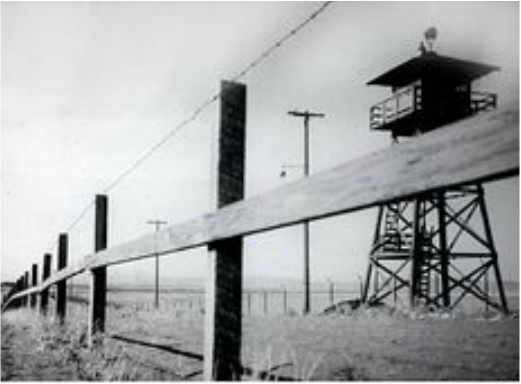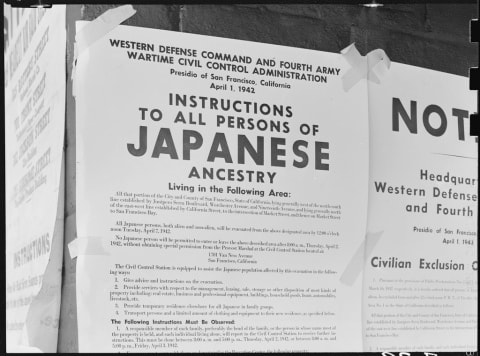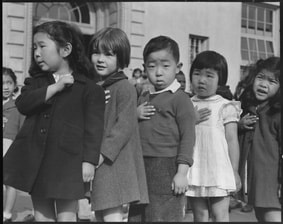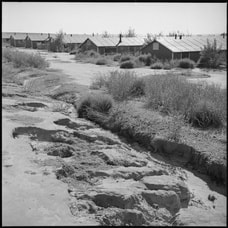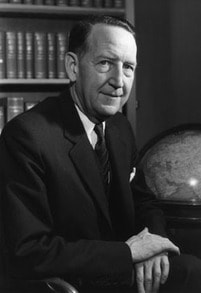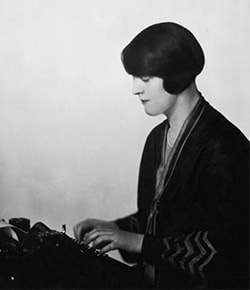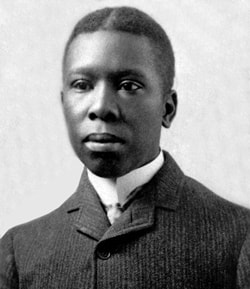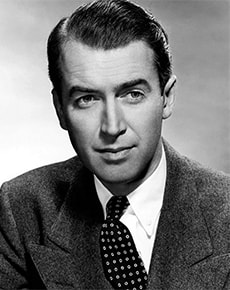Photo by Jeffrey Beall - Own work, CC BY 3.0, https://commons.wikimedia.org/w/index.php?curid=28186235
What a rich, real life portrayal of the human family—given, chosen, or thrust upon us! Yes, the relationships are riven but also mended, repaired, and preserved. . . . I ended the book feeling frustrated yet hopeful about the human condition. . . . This story is a beautiful model of what we might accomplish if we just took time to learn another human being's story, understand their condition, embrace our differences, and do the hard work of sitting down at the loom [to weave them into the fabric of community].
Darlene B.
I was completely absorbed into the town of Greenwood and didn’t want to leave. The characters are as complex and flawed as our nation’s domestic response was to the bombing of Pearl Harbor.
Anonymous
COLORADO'S HIGH PLAINS IN THE 1940S
Caddoa Dam and Camp Amache
Prior to Pearl Harbor, not only did anxiety about the European War, conscription, and defense production affect Southeastern Colorado, where fictional Greenwood County is located. Construction began on the Caddoa Dam. John Martin, Colorado U.S. Representative, had advocated persistently for it, and by early 1940 the first step toward its completion began: rerouting a segment of the Santa Fe Railroad tracks. Community welfare offices started preparing for the "heavy incursion of transients" who would work at the dam site. The dam was the second largest project ever to come to the state, and by May 1940, over 250 employees and their families moved into the area. Business thrived, as did the boomtown that grew up near the dam construction site. Captain James H. Stratton (Army Corps of Engineers) was the District Engineer of the Caddoa district and also eventually oversaw airfield and airport projects in the area and in New Mexico.
By March 1941, 300 men were on the weekly payroll, which doubled with warmer weather. Housing was at a premium, crime increased, and the county commissioners and a local city council limited the hours for 3.2 beer sales because of "considerable trouble." Construction slowed and then stopped by the end of 1942 as building and labor resources were diverted to the war effort. Representative Martin died the year construction began, and in 1940 the dam and reservoir were renamed in his honor. The dam was completed in 1948.
Just as construction on the dam wound down in 1942, that on Camp Amache accelerated, not fifty miles away. Its name was derived from Amache, a Cheyenne and daughter of one of Black Kettle's sub-chiefs, Ochinee (One Eye). Ochinee had negotiated a truce between the Cheyenne, Arapaho, and the U.S. government, which guaranteed a safe camping area at their reservation along Sand Creek. However, on November 29, 1864, despite the fact that an American flag flew over the camp, the Colorado US Volunteer Cavalry attacked and destroyed it, killing 150 Cheyenne and Arapaho, among them, Chief Ochinee. Amache was married to John Prowers, a Colorado cattleman, and was not present at the massacre. Prowers County was named after him, was the location of Camp Amache, and was part of the original Greenwood County.
By March 1941, 300 men were on the weekly payroll, which doubled with warmer weather. Housing was at a premium, crime increased, and the county commissioners and a local city council limited the hours for 3.2 beer sales because of "considerable trouble." Construction slowed and then stopped by the end of 1942 as building and labor resources were diverted to the war effort. Representative Martin died the year construction began, and in 1940 the dam and reservoir were renamed in his honor. The dam was completed in 1948.
Just as construction on the dam wound down in 1942, that on Camp Amache accelerated, not fifty miles away. Its name was derived from Amache, a Cheyenne and daughter of one of Black Kettle's sub-chiefs, Ochinee (One Eye). Ochinee had negotiated a truce between the Cheyenne, Arapaho, and the U.S. government, which guaranteed a safe camping area at their reservation along Sand Creek. However, on November 29, 1864, despite the fact that an American flag flew over the camp, the Colorado US Volunteer Cavalry attacked and destroyed it, killing 150 Cheyenne and Arapaho, among them, Chief Ochinee. Amache was married to John Prowers, a Colorado cattleman, and was not present at the massacre. Prowers County was named after him, was the location of Camp Amache, and was part of the original Greenwood County.
The complex characters [in the novel] are good and kind but caught up in a dark time with historical forces pressing them into making a moral stand. Some make their decisions based on love and courage, while others follow their fear; reading this book prompted me to question where I would stand.
Althea Danielski
1940s - Government-produced film explaining and defending
the internment of Japanese Americans in war relocation camps
during WWII. Copyright Rick Ray.
the internment of Japanese Americans in war relocation camps
during WWII. Copyright Rick Ray.
After President Franklin D. Roosevelt authorized the forced relocation of those with Japanese ancestry living on the West Coast, during the spring and summer of 1942 almost 120,000 people were uprooted from their homes and sent to "assembly centers." Camp Amache started receiving its first internees from the centers at the end of August. Amache became the tenth largest city in Colorado with a peak population of almost 8,000 residents crowded into flimsy barracks.
The camp was surrounded by barbed wire fencing and eight machine gun towers. Those who were incarcerated worked on the surrounding agricultural land, producing food for the camp and enough surplus for other internment camps and the US Army. For more information about the internment camps, please go to the "Resources" page.
The camp was surrounded by barbed wire fencing and eight machine gun towers. Those who were incarcerated worked on the surrounding agricultural land, producing food for the camp and enough surplus for other internment camps and the US Army. For more information about the internment camps, please go to the "Resources" page.
Photos courtesy of the National Archives and Records Administration.
|
Original WRA caption: San Francisco, California. Exclusion Order posted at First and Front Streets directing removal of persons of Japanese ancestry from the first San Francisco section to be effected by the evacuation.
|
Original caption: San Francisco, California. Many children of Japanese ancestry attended Raphael Weill public School...prior to evacuation. This scene shows first- graders during flag pledge ceremony. Evacuees of Japanese ancestry will be housed in War Relocation Authority centers for the duration.
|
Original WRA caption (following the camp's closure): Granada Relocation Center, Amache, Colorado. Weeds are already taking over where recently thousands of evacuees moved about between their temporary homes and the mess halls, schools and churches of various denominations.
|
HISTORICAL FIGURES IN GREENWOOD RIVEN
LLEWELLYN THOMPSONLlewellyn Thompson, son of a Baptist minister/rancher, was born in Bent County, part of the Colorado Territory's original Greenwood County. A graduate of the University of Colorado, he joined the Foreign Service in 1929 and worked in embassies around the world, serving as ambassador in Moscow during the Cold War, from 1957-1962 and again from 1967-1969. He had lived with Nikita Khrushchev and his wife for a time and advised President Kennedy during the Cuban Missile Crisis.
As second secretary of the American Embassy in Moscow in 1941, Thompson remained to face Hitler's shelling in order to look after US and British interests. He spent one night in a crowded, bomb-proof subway and decided to live, instead, in the old Pierce Arrow car provided for his escape should the Germans break through. By US Govermnent - http://moscow.usembassy.gov/links/ambassadors.php, Public Domain, https://commons.wikimedia.org/w/index.php?curid=1338866 DOROTHY THOMPSONDorothy Thompson (no relation to Llewellyn Thompson) was called by some the First Lady of American Journalism and regarded during the war as the second most influential woman in America next to Eleanor Roosevelt.
Working as head of the New York Post's Berlin bureau, in 1934 Thompson was the first American journalist expelled from Germany due to her critical comments about Hitler and the National Socialist Party (Nazis). For example, after her 1931 interview of Hitler, she wrote that it took her less than fifty seconds in his presence to realize he was the "prototype of the Little Man." In his dark gray eyes she saw "that peculiar shine which often distinguishes geniuses, alcoholics, and hysterics." She became an NBC radio news commentator and a New York Herald Tribune columnist, opposite Walter Lippmann. In 1939, a Time magazine issue featured her on the cover with this quotation in the article: "Dorothy Thompson is the U.S. clubwoman's woman. She is read, believed and quoted by millions of women who used to get their political views from Walter Lippmann." By Unknown - ViewImages.com, Public Domain, https://commons.wikimedia.org/w/index.php?curid=3691566 |
PAUL LAURENCE DUNBARPaul Laurence Dunbar, whose poem so moved Zella Behm, was an acclaimed poet with an international reputation in late nineteenth century America, a friend and schoolmate of the Wright brothers, and the son of a freedman who fought in the Union Army. A child prodigy, Dunbar was the only black student at Dayton Central High School in Ohio, class president, and editor of the school's literary magazine.
Dunbar wrote in both a formal lyric tradition and in dialect and is a pivotal figure in African-American letters. He died all too young of tuberculosis at age thirty-three. In 1899, Dunbar lived in Denver for several weeks and wrote poetry and essays for The Denver Post. By The African-American Experience in Ohio, 1850-1920, Ohio Historical Society, Library of Congress, Public Domain, https://commons.wikimedia.org/w/index.php?curid=16835163 JIMMY STEWARTAnother widely admired historical figure of the time was Jimmy Stewart, the movie actor, also known today as a World War II and Vietnam War veteran who achieved the rank of Brigadier General in the United States Air Force Reserve.
However, Martha and Art knew him as the idealistic politician in the 1939 film Mr. Smith Goes to Washington and the winner of the Academy Award for Best Actor for his role opposite Katharine Hepburn in The Philadelphia Story (1941). Stewart was drafted in late 1940, already a proficient pilot, but he failed his first two physicals for being five pounds underweight. Eventually he passed and was inducted in March 1941. He would have been assigned to duties stateside, in recruiting films, had he not pursued his goal to become a commander of a bombardment group. Eventually he led attacks as a command pilot deep into Nazi-occupied Europe. By Studio publicity still - [1], Public Domain, https://commons.wikimedia.org/w/index.php?curid=14857265 |
